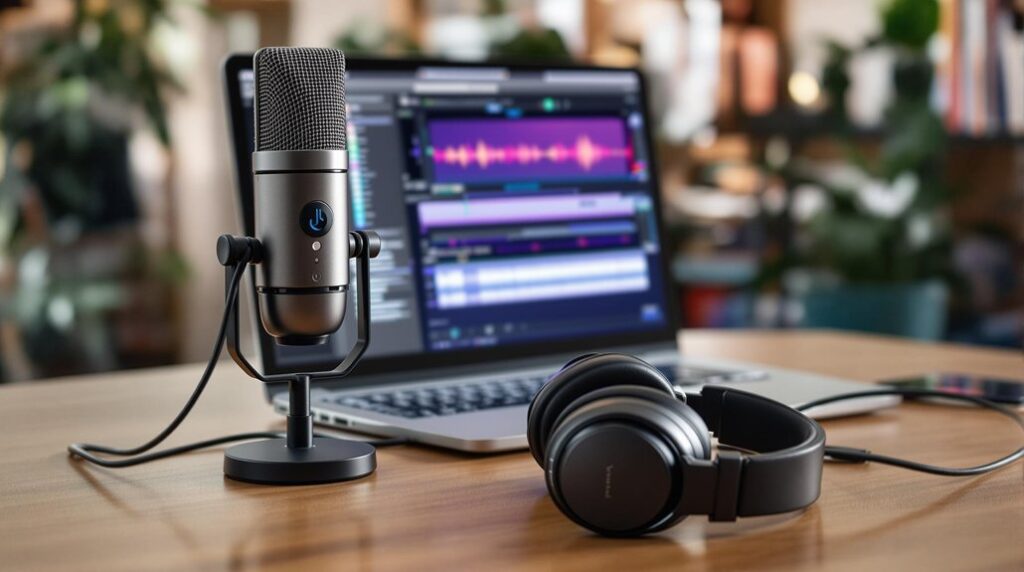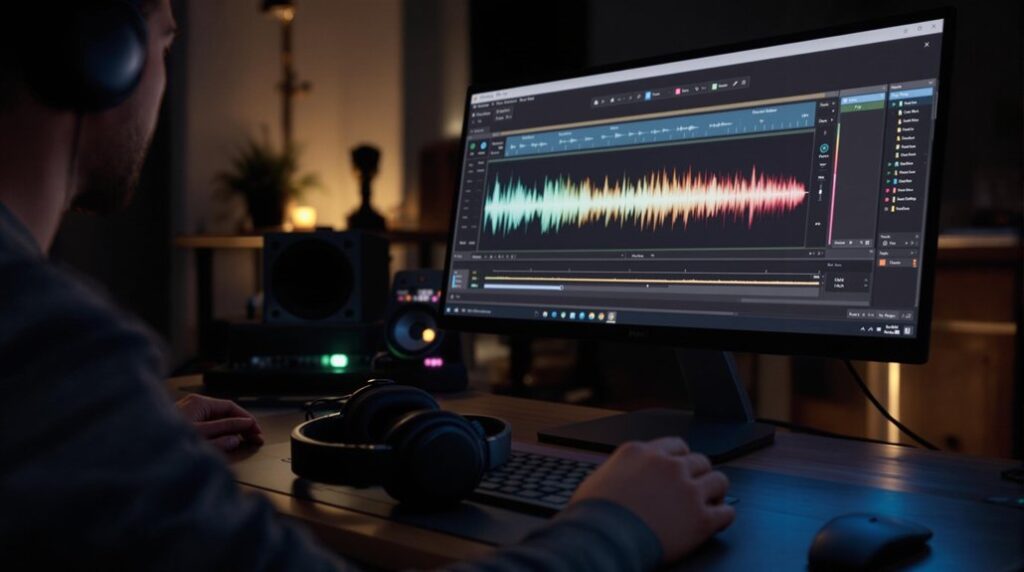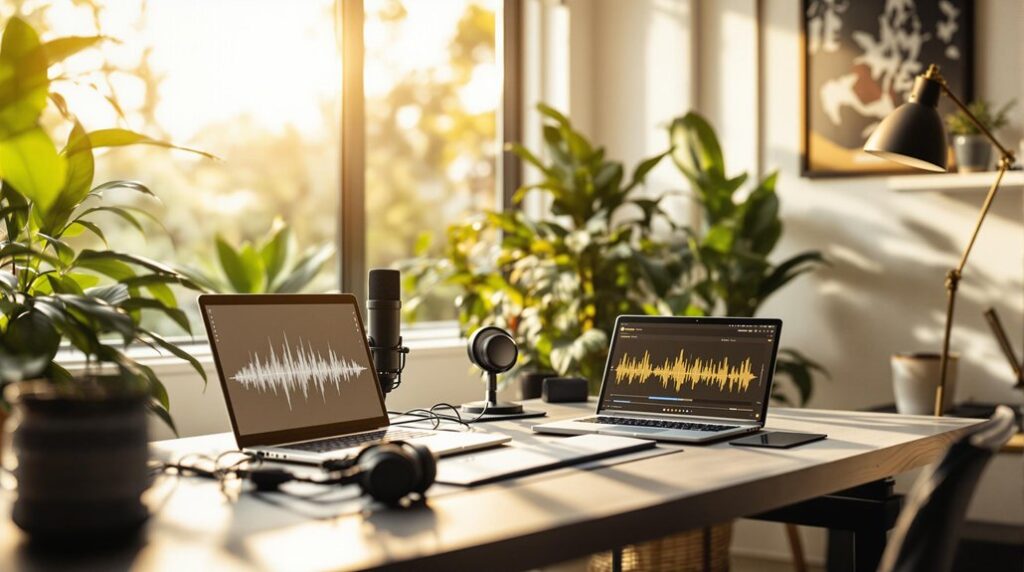To import video audio into Audacity, start by downloading both Audacity and the FFmpeg library, ensuring you select the FFmpeg option during installation. Next, configure FFmpeg by accessing Audacity’s Preferences and confirming its detection in the Libraries section. Then, go to the File menu, select Import, and choose Audio to locate your video file, such as an MP4. Double-click to extract audio. Finally, edit your audio tracks with Audacity’s effects before exporting in your desired format. By following these steps, you’ll master audio importation and discover additional tips for optimizing your audio projects.
Key Takeaways
- Install Audacity and ensure FFmpeg is configured for audio extraction from video files.
- Open Audacity and navigate to the File menu, then select Import.
- Choose Audio and locate your desired video file (e.g., MP4).
- Double-click the video file to extract audio for editing.
- Use Audacity’s editing tools to refine the extracted audio as needed.
Installing Audacity and FFmpeg
To get started with importing audio into Audacity, you’ll need to install both Audacity and the FFmpeg library.
Begin by downloading Audacity from its official website. During the installation process, make sure you select the FFmpeg library option; this step is vital for enabling audio extraction from video files.
Once installed, open Audacity and navigate to the preferences menu to verify that the FFmpeg library is detected successfully. This confirmation is important before you attempt to import video.
After confirming, you can easily import video files like MP4 by accessing the File menu, selecting Import, and choosing your desired video.
Remember to check that the audio formats you plan to edit, such as WAV or MP3, are compatible with Audacity for best performance. Additionally, ensure that you have a proper audio input configuration to facilitate seamless editing and recording.
Configuring FFmpeg in Audacity
Configuring FFmpeg in Audacity is essential for enabling the software to import audio from various video formats. First, verify you’ve downloaded and installed the FFmpeg library. Open Audacity, go to the Preferences menu under the Edit tab, and locate the Libraries section. Click the “Locate” button to find and confirm your FFmpeg installation. Once detected, a confirmation pop-up will appear. Click “OK” to finalize the configuration, which allows Audacity to import audio from formats like MP4 efficiently.
Here’s a quick reference table:
| Step | Action |
|---|---|
| 1. Download FFmpeg | Visit the official FFmpeg website |
| 2. Install FFmpeg | Follow installation instructions |
| 3. Open Audacity | Launch the application |
| 4. Access Preferences | Click on Edit > Preferences |
| 5. Confirm Installation | Use Locate to set up FFmpeg |
Importing Video Files
While Audacity primarily focuses on audio editing, it can also extract audio from video files with the help of the FFmpeg library.
To start importing video files, follow these steps:
- Navigate to the File menu and select Import.
- Choose Audio to locate the desired video file (e.g., MP4).
- Double-click the video file to extract and import its audio track into Audacity’s workspace.
Ensure that you’ve configured the FFmpeg library correctly in Audacity’s preferences to enable seamless audio extraction.
Once you’ve imported the audio, you can proceed with editing the audio using Audacity’s robust tools, allowing for a range of adjustments before exporting your work in formats like MP3, WAV, or OGG.
Editing Audio Tracks
When you plunge into editing audio tracks in Audacity, you’ll discover a suite of powerful tools designed to enhance your sound quality and refine your mix. To get started, consider the following effects:
| Effect | Purpose |
|---|---|
| Amplify | Adjust overall volume without distortion |
| Equalization | Shape specific frequency bands for a cleaner mix |
| Compressor | Reduce dynamic range, balancing loud and quiet |
| Reverb | Add depth and space for an immersive experience |
In addition to these effects, understanding reverb time (RT60) can greatly assist in managing unwanted reverb in your audio tracks. Use these tools to effectively edit the audio in Audacity. Experiment with Fade In and Fade Out effects for smooth shifts, ensuring a polished final product. With practice, you’ll master these techniques, ultimately elevating your audio quality to new heights.
Exporting Final Audio
After polishing your audio tracks with various editing effects, the next step is to export your final product. Audacity serves as a powerful tool for this process.
Follow these steps to guarantee your audio quality meets your needs:
- Navigate to the File menu and select Export.
- Choose your desired format (like MP3 or WAV) and configure the bitrate for peak audio quality.
- Name your MP4 file clearly and specify a destination folder for easy retrieval.
Once you’ve confirmed your settings, click Save and input any additional metadata, such as artist name or track title. Remember to ensure that your export settings align with industry loudness standards to maintain the integrity of your audio.
After the export completes, you’ll receive a notification, indicating your audio is ready for sharing or use in videos.
Frequently Asked Questions
How to Import Video Audio in Audacity?
To import video audio in Audacity, guarantee you’ve installed FFmpeg for compatible import formats. Once imported, apply editing techniques to enhance audio quality before exporting your final project in your preferred format.
How to Extract Audio From Video for Audacity?
To extract audio, you’ll need audio extraction tools compatible with video file formats. Once you’ve got your video loaded in your editing software options, simply initiate the extraction process to access the audio track for further editing.
How to Convert Video Into Audio in Audacity?
To convert video into audio in Audacity, guarantee software compatibility by installing FFmpeg. Import your video file, extract audio, and edit. Finally, export in various audio formats like MP3 or WAV for your needs.
Can Audacity Take Video Files?
Audacity can’t directly handle video files due to software compatibility issues. However, by installing FFmpeg, you can extract audio formats from videos, enabling effective audio editing within Audacity, enhancing your workflow for video editing projects.
Conclusion
To sum up, importing video audio into Audacity can be accomplished seamlessly by following the outlined steps. By installing Audacity and configuring FFmpeg, you enable the software to handle various video formats effectively. Once imported, you can edit your audio tracks with precision, ensuring top-notch quality. Finally, exporting your work allows for easy sharing and integration into other projects. With these straightforward steps, you can enhance your audio editing experience efficiently and effectively.




